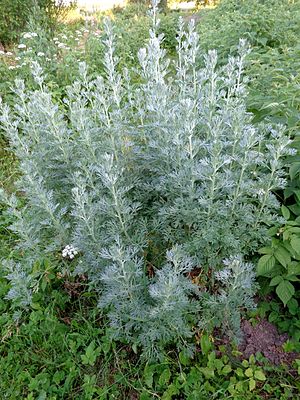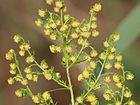Note: This is a project under development. The articles on this wiki are just being initiated and broadly incomplete. You can Help creating new pages.
Difference between revisions of "Artemisia - Indhana"
m (Prabhakar moved page Indhana (Artemisia) to Artemisia - Indhana) |
(→References) |
||
| (17 intermediate revisions by 2 users not shown) | |||
| Line 1: | Line 1: | ||
[[File:Artemisia absinthium 01.JPG|thumb|right|''Indhana'', ''Artemisia'']] | [[File:Artemisia absinthium 01.JPG|thumb|right|''Indhana'', ''Artemisia'']] | ||
| + | '''Indhana''' is a large, diverse genus of plants with between 200 and 400 species. It belongs to daisy family Asteraceae. Artemisia species grows in temperate climates of both hemispheres, usually in dry or semiarid habitats. | ||
| + | ==Uses== | ||
| + | {{Uses|Malaria}}, {{Uses|Cancer}}, {{Uses|Crohn’s Disease}}, {{Uses|Salmonella}}, {{Uses|SIBO}}, {{Uses|Bloated stomach}}, {{Uses|Porphyria}}, {{Uses|Diarrhea}}, {{Uses|Sore throats}} | ||
| − | + | ==Parts Used== | |
| + | {{Parts Used|Leaves}}, {{Parts Used|Flowers}}. | ||
| − | + | ==Chemical Composition== | |
| + | Flavonoids, Quercitin 3-glucoside, Quercitin 3-rhamnoglucoside, Spinacetin 3-glucoside, spinacetin 3-rhamnoglucoside, and others<ref name="chemical composition"/> | ||
| − | == | + | ==Common names== |
| + | {{Common names|kn=Urigattige, Uruvalu|ml=Nilampala, Shulabandha|sa=Damar, Indhana|ta=Macipattiri, Macippaccai|te=Moshipatri, Tartiha|hi=Vilayati Afsantin|en=Wormwood, Bsinthium}} | ||
| − | + | ==Properties== | |
| + | Reference: Dravya - Substance, Rasa - Taste, Guna - Qualities, Veerya - Potency, Vipaka - Post-digesion effect, Karma - Pharmacological activity, Prabhava - Therepeutics. | ||
| + | ===Dravya=== | ||
| − | == | + | ===Rasa=== |
| + | Tikta (Bitter), Kashaya (Astringent) | ||
| + | ===Guna=== | ||
| + | Laghu (Light), Ruksha (Dry), Tikshna (Sharp) | ||
| + | ===Veerya=== | ||
| + | Ushna (Hot) | ||
| + | ===Vipaka=== | ||
| + | Katu (Pungent) | ||
| + | ===Karma=== | ||
| + | Tridosha shamaka | ||
| + | ===Prabhava=== | ||
| − | + | ==Habit== | |
| − | + | {{Habit|Perennial shrub}} | |
| − | |||
| − | |||
| − | |||
| − | |||
| − | |||
| − | = | ||
| − | + | ==Identification== | |
| − | + | ===Leaf=== | |
| − | + | {{Leaf|Simple|Spirally|Greenish-grey above and white below, covered with silky silvery-white trichomes and bearing minute oil-producing glands}}<ref name="Leaf"/> | |
| − | == | + | ===Flower=== |
| + | {{Flower|Unisexual|2-4cm long|Pale yellow|5|Tubular, and clustered in spherical bent-down heads, which are in turn clustered in leafy and branched panicles}} | ||
| − | + | ===Fruit=== | |
| − | <ref name=" | + | {{Fruit|Achene|Seed dispersal is by gravity|It grows naturally on uncultivated, arid ground, on rocky slopes, and at the edge of footpaths and fields|With hooked hairs|Many}} |
| − | <ref name=" | + | |
| − | + | ===Other features=== | |
| + | |||
| + | ==List of Ayurvedic medicine in which the herb is used== | ||
| + | * [[Vishatinduka Taila]] as ''root juice extract'' | ||
| + | |||
| + | ==Where to get the saplings== | ||
| + | ==Mode of Propagation== | ||
| + | {{Propagation|Seeds}}, {{Propagation|Cuttings}}. | ||
| + | |||
| + | ==How to plant/cultivate== | ||
| + | The genus Artemisia includes a large number of species and some have been cultivated as commercial crops with a wide diversity of uses<ref name="How to plant/cultivate"/> | ||
| + | |||
| + | ==Commonly seen growing in areas== | ||
| + | {{Commonly seen|Temperate Area}}, {{Commonly seen|Northern Africa}}, {{Commonly seen|Western Asia}}. | ||
| + | |||
| + | ==Photo Gallery== | ||
| + | <gallery class="left" caption="" widths="140px" heights="140px"> | ||
| + | Artemisia annua - Botanischer Garten Mainz IMG 5638.JPG|<center>Leaves<center> | ||
| + | Artemisia annua detail.jpeg|<center>Flowers<center> | ||
| + | Artemisia annua West Virginia.jpg|<center>Feild<center> | ||
| + | Artemisia annua.jpeg|<center>Buds<center> | ||
| + | Artemisia annua.jpg|<center>Whole herb<center> | ||
| + | Artemisiaannua.jpg|<center>Seeds<center> | ||
| + | </gallery> | ||
| + | |||
| + | ==References== | ||
| + | |||
| + | <references> | ||
| + | <ref name="chemical composition">[https://draxe.com/wormwood/ Chemistry]</ref> | ||
| − | = | + | <ref name="Leaf">[https://www.flowersofindia.net/catalog/slides/Wormwood.html Flowers description]</ref> |
| − | + | <ref name="How to plant/cultivate">[http://medicinalplants.us/cultivation-of-artemisia Cultivation of Artemisia]</ref> | |
| + | </references> | ||
| + | ==External Links== | ||
| + | * [https://www.herbal-supplement-resource.com/wormwood-herb.html Wormwood Herb – Health Benefits and Side Effects] | ||
| + | * [https://www.bhg.com/gardening/plant-dictionary/perennial/artemisia/ Artemisia-better home and gardens] | ||
| + | * [https://draxe.com/wormwood/ Wormwood: The Parasite-Killing, Cancer-Fighting Super Herb] | ||
| + | * [http://www.finegardening.com/genus/artemisia Artemisia on fine gardenia] | ||
| + | * [https://www.britannica.com/plant/artemisia-plant Artemisia on encyclopedea britanicca] | ||
[[Category:Herbs]] | [[Category:Herbs]] | ||
| + | [[Category:Asteraceae]] | ||
Latest revision as of 15:59, 27 March 2020
Indhana is a large, diverse genus of plants with between 200 and 400 species. It belongs to daisy family Asteraceae. Artemisia species grows in temperate climates of both hemispheres, usually in dry or semiarid habitats.
Contents
- 1 Uses
- 2 Parts Used
- 3 Chemical Composition
- 4 Common names
- 5 Properties
- 6 Habit
- 7 Identification
- 8 List of Ayurvedic medicine in which the herb is used
- 9 Where to get the saplings
- 10 Mode of Propagation
- 11 How to plant/cultivate
- 12 Commonly seen growing in areas
- 13 Photo Gallery
- 14 References
- 15 External Links
Uses
Malaria, Cancer, Crohn’s Disease, Salmonella, SIBO, Bloated stomach, Porphyria, Diarrhea, Sore throats
Parts Used
Chemical Composition
Flavonoids, Quercitin 3-glucoside, Quercitin 3-rhamnoglucoside, Spinacetin 3-glucoside, spinacetin 3-rhamnoglucoside, and others[1]
Common names
| Language | Common name |
|---|---|
| Kannada | Urigattige, Uruvalu |
| Hindi | Vilayati Afsantin |
| Malayalam | Nilampala, Shulabandha |
| Tamil | Macipattiri, Macippaccai |
| Telugu | Moshipatri, Tartiha |
| Marathi | NA |
| Gujarathi | NA |
| Punjabi | NA |
| Kashmiri | NA |
| Sanskrit | Damar, Indhana |
| English | Wormwood, Bsinthium |
Properties
Reference: Dravya - Substance, Rasa - Taste, Guna - Qualities, Veerya - Potency, Vipaka - Post-digesion effect, Karma - Pharmacological activity, Prabhava - Therepeutics.
Dravya
Rasa
Tikta (Bitter), Kashaya (Astringent)
Guna
Laghu (Light), Ruksha (Dry), Tikshna (Sharp)
Veerya
Ushna (Hot)
Vipaka
Katu (Pungent)
Karma
Tridosha shamaka
Prabhava
Habit
Identification
Leaf
| Kind | Shape | Feature |
|---|---|---|
| Simple | Spirally | Greenish-grey above and white below, covered with silky silvery-white trichomes and bearing minute oil-producing glands |
Flower
| Type | Size | Color and composition | Stamen | More information |
|---|---|---|---|---|
| Unisexual | 2-4cm long | Pale yellow | 5 | Tubular, and clustered in spherical bent-down heads, which are in turn clustered in leafy and branched panicles |
Fruit
| Type | Size | Mass | Appearance | Seeds | More information |
|---|---|---|---|---|---|
| Achene | Seed dispersal is by gravity | It grows naturally on uncultivated, arid ground, on rocky slopes, and at the edge of footpaths and fields | With hooked hairs | Many | {{{6}}} |
Other features
List of Ayurvedic medicine in which the herb is used
- Vishatinduka Taila as root juice extract
Where to get the saplings
Mode of Propagation
How to plant/cultivate
The genus Artemisia includes a large number of species and some have been cultivated as commercial crops with a wide diversity of uses[3]
Commonly seen growing in areas
Temperate Area, Northern Africa, Western Asia.
Photo Gallery
References
External Links
- Ayurvedic Herbs known to be helpful to treat Malaria
- Ayurvedic Herbs known to be helpful to treat Cancer
- Ayurvedic Herbs known to be helpful to treat Crohn’s Disease
- Ayurvedic Herbs known to be helpful to treat Salmonella
- Ayurvedic Herbs known to be helpful to treat SIBO
- Ayurvedic Herbs known to be helpful to treat Bloated stomach
- Ayurvedic Herbs known to be helpful to treat Porphyria
- Ayurvedic Herbs known to be helpful to treat Diarrhea
- Ayurvedic Herbs known to be helpful to treat Sore throats
- Herbs with Leaves used in medicine
- Herbs with Flowers used in medicine
- Herbs with common name in Kannada
- Herbs with common name in Hindi
- Herbs with common name in Malayalam
- Herbs with common name in Tamil
- Herbs with common name in Telugu
- Herbs with common name in Sanskrit
- Herbs with common name in English
- Habit - Perennial shrub
- Index of Plants which can be propagated by Seeds
- Index of Plants which can be propagated by Cuttings
- Herbs that are commonly seen in the region of Temperate Area
- Herbs that are commonly seen in the region of Northern Africa
- Herbs that are commonly seen in the region of Western Asia
- Herbs
- Asteraceae






